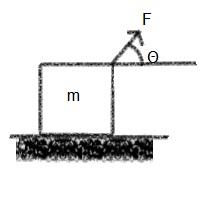What to do and what not to do in the last month before IIT-JEE
http://www.youtube.com/watch?v=Z5-AfiJxjOc&context=C4acfebbADvjVQa1PpcFMQX-FKsRHXxJDA7RTt_k4sN1NL6Iapsuo=

A force F acts on a block of mass m placed on a horizontal smooth surface at an angle Θ with horizontal. Then
(A) If F sinΘ < mg then a = F + mgm
(B) Acceleration = FCosΘm when F > mg cosecΘ
(C) Acceleration = FM if F SinΘ > mg
(D) If F sinΘ > mg then a = F + mgm
Hey!! the image i uploaded is not visible.... what's wrong with this site...
Admin... u must bring some improvement in this site.. :{
I have seen similar problem in Irodov also. And Yes the images are not working. I had to use tinypic.
What to do and what not to do in the last month before IIT-JEE
http://www.youtube.com/watch?v=Z5-AfiJxjOc&context=C4acfebbADvjVQa1PpcFMQX-FKsRHXxJDA7RTt_k4sN1NL6Iapsuo=
It's because, though you have used the vectors, you have used the minus sign in front of mg. If you are using vectors, you can always add them without thinking too much for the sign.
"though you have used the vectors, you have used the minus sign in front of mg"
ok
"If you are using vectors, you can always add them without thinking too much for the sign."
didn't get this?
please explain...!!
do u mean that it won't be bringing any change in magnitude.. or something else..?
as in both the cases the magnitude has to be √(F)2 + (mg)2m
@rahul - mg is a vector which is pointing vertically downward, so why are you applying the negative sign before it ??
on drawing the F.B.D we get,
F sinΘ + N - mg = may
Now, if F sinΘ > mg then N vanishes
so, F sinΘ- mg = may --- (i)
Again, F cosΘ = max ---- (ii)
Adding these two we get,
F sinΘ + F cosΘ - mg = may + max
or, ax + ay = (F - mg) / m
that's the reason i guess....!!